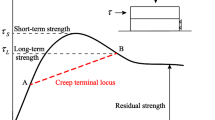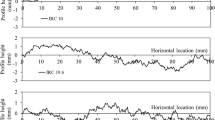Abstract
The closure and shear behaviors of 3D self-affine rock joints are simulated by the Discrete Element Method using PFC3D. First, a methodology to produce rough self-affine rock joints using DEM is presented then eight self-affine rough joints, having low and high values of roughness exponent, self-affine correlation length, and height variance, are considered. After the calibration of the elastic and fracture behaviors of an elementary volume formed from spherical discrete elements bonded by elastic beams, the numerical rock joints are submitted to closure tests at 14 and 21 MPa followed by a shear test at constant velocity and under constant normal load. Each DEM joint is tested using three different mechanical models: rigid, ideally elastic and elastic-fracturing. The use of these three models allows highlighting the distinct influences of the morphology, the joint stiffness and the micro-fracturing on the closure and shear behaviors of the joints.
















Similar content being viewed by others
References
André D, Iordanoff I, Charles LC, Néauport J (2012) Discrete element method to simulate continuous material by using the cohesive beam model. Comput Methods Appl Mech Eng 213–216:113–125
Archambault G, Gentier S, Riss J, Flamand R (1997) The evolution of void spaces (permeability) in relation with rock joint shear behavior. Int J Rock Mech Min Sci 34:3–4
Babadagli T, Develi K (2003) Fractal characteristics of rocks fractured under tension. Theor Appl Fract Mech 39:73–88
Bahaaddini M, Sharrock G, Hebblewhite BK (2013) Numerical direct shear tests to model the shear behavior of rock joints. Comput Geotech 51:101–115
Bandis S, Lumsden AC, Barton NR (1981) Experimental studies of scale effects on the shear behavior of rock joints. Int J Rock Mech Min Sci 18:1–21
Barton N (1982) Modelling rock joint behavior from in situ block tests: implications for nuclear waste repository design. Technical Report ONWI-308. Terra Teck, Inc. for Office of Nuclear Waste Isolation, Battelle Memorial Institute, Columbus, OH
Barton N, Bandis S (1990) Review of predictive capabilities of JRC-JCS model in engineering practice. In: International symposium on rock joints, Loen, 4-6 Juin, pp 603–610
Barton NR, Bandis S, Bakhtar K (1985) Strength, deformation and conductivity coupling of rock joints. Int J Rock Mech Min Sci Geomech Abstr 22:121–40
Barton N, Choubey V (1977) The shear strength of rock joints in theory and practice. Rock Mech 10:1–54
Belem T, Homand-Etienne F, Souley M (1997) Fractal analysis of shear joint roughness. Int J Rock Mech Min Sci 34:3–4
Bouchaud E (1997) Scaling properties of cracks. J Phys Condens Matter 9:4319–4344
Brown SR, Scholz CH (1986) Closure of rock joints. J Geophys Res 91:4939–4948
Byerlee JD (1978) Friction of rocks. Pageoph 116:615–626
Candela T, Renard F, Bochon M, Brouste A, Marsan D, Schmittbuhl J, Voisin C (2009) Characterization of fault roughness at various scales: implications of three-dimensional high-resolution topography measurements. Pure Appl Geophys 166:1817–1851
Cho N, Martin CD, Sego DC (2007) A clumped particle model for rock. Int J Rock Mech Min Sci 44:997–1010
Cho N, Martin CD, Sego DC (2008) Development of a shear zone in brittle rock subjected to direct shear. Int J Rock Mech Min Sci 45:1335–1346
Cundall PA, Strack ODL (1979) A discrete numerical model for granular assemblies. Géotechnique 29(1):47–65
Develi K, Babadagli T (1998) Quantification of natural fracture surfaces using fractal geometry. Math Geol 30:971–998
Dieterich JH, Kilgore BD (1996) Imaging surface contacts: power-law contact distributions and contact stresses in quartz, calcite, glass and acrylic plastic. Tectonophysics 256:219–239
Duriez J, Darve F, Donzé FV (2011) A discrete modeling-based constitutive relation for infilled rock joints. Int J Rock Mech Min Sci 48:458–468
Flamand R. (2000) Validation d’un modèle de comportement mécanique pour les fractures rocheuses en cisaillement. PhD Thesis, Université du Québec à Chicoutimi
Gentier S (1986) Morphologie et comportement hydromécanique d’une fracture naturelle dans le granite sous contrainte normale–etude expérimentale et théorique. PhD Thesis, Université d’Orléans
Gentier S, Riss J, Archambault G, Flamand R, Hopkins D (2000) Influence of fracture geometry on shear behavior. Int J Rock Mech Min Sci 37:161–174
Hinojosa M, Reyes E, Guerra C, González V, Ortiz U (2008) Scaling properties of slow fracture in glass: from deterministic to irregular topography. Int J Fract 151:81–93
Itasca (2008) User manual, PFC3D version 4.0
Karami A, Stead D (2008) Asperity degradation and damage in the direct shear test: a hybrid FEM–DEM approach. Rock Mech Rock Eng 41:229–266
Kwasniewski MA, Wang JA (1997) Surface roughness evolution and mechanical behavior of rock joints under shear. Int J Rock Mech Min Sci 34:3–4
Lopez JM, Schmittbuhl J (1998) Anomalous scaling of fracture surfaces. Phys Rev E 57:6405–6409
Maksimovic M (1996) The shear strength components of a rough rock joint. Int J Rock Mech Min Sci Geomech Abstr 33:769–783
Marache A. (2002) Comportement mécanique d’une fracture rocheuse sous contraintes normale et tangentielle. École Centrales des Arts et Manufactures. PhD Thesis, École Centrale Paris
Moon T, Nakagawa M, Berger J (2007) Measurement of fracture toughness using the distinct element method. Int J Rock Mech Min Sci 44:449–456
Morel S, Bonamy D, Ponson L, Bouchaud E (2008) Transient damage spreading and anomalous scaling in mortar crack surfaces. Phys Rev E 78:1–5
Mourot G, Morel S, Bouchaud E, Valentin G (2005) Anomalous scaling of mortar fracture surfaces. Phys Rev E 71:6405–6408
Mourot G, Morel S, Bouchaud E, Valentin G (2006) Scaling properties of mortar fracture surfaces. Int J Fract 140:39–54
Murata S, Saito T (1999) The variogram method for a fractal model of a rock joint surface. Geotech Geol Eng 17:197–210
Odling NE (1994) Natural fracture profiles, fractal dimension and joint roughness coefficients. Rock Mech Rock Eng 27:135–153
Ogilvy JA (1991) Numerical simulation of friction between contacting rough surfaces. J Phys D Appl Phys 24:2098–2109
Park JW, Lee JK, Song JJ, Choi BH (2012) A constitutive model for the shear behavior of rock joints based on three-dimensional quantification of joint roughness. Rock Mech Rock Eng 46:1513–1537
Park JW, Song JJ (2009) Numerical simulation of a direct shear test on a rock joint using a bonded-particle model. Int J Rock Mech Min Sci 46:1315–1328
Park JW, Song JJ (2013) Numerical method for the determination of contact areas of a rock joint under normal and shear loads. Int J Rock Mech Min Sci 58:8–22
Potyondy DO, Cundall PA (2004) A bonded-particle model for rock. Int J Rock Mech Min Sci 41:1329–1364
Power WL, Durham WB (1997) Topography of natural and artificial fractures in granitic rocks: implications for studies of rock friction and fluid migration. Int J Rock Mech Min Sci 34:979–989
Riss J, Gentier S, Archambault G, Flamand R (1997) Sheared rock joints: dependence of damage zones on morphological anisotropy. Int J Rock Mech Min Sci 34:3–4
Riss J, Gentier S, Laffréchine K, Flamand R, Archambault G (1996) Binary images of sheared rock joints: characterization of damaged zones. Microsc Microanal Microstruct 7:521–526
Renard F, Schmittbuhl J, Gratier JP, Meakin P, Merino E (2004) Three-dimensional roughness of stylolites in limestones. J Geophys Res 109:1–12
Renard F, Voisin C, Marsan D, Schmittbuhl J (2006) High-resolution 3D laser scanner measurements of a strike-slip fault quantify its morphological anisotropy at all scales. Geophys Res Lett 33:1–4
Santucci S, Maloy KJ, Delaplace A (2007) Statistics of fracture surfaces. Phys Rev E 75:1–6
Schmittbuhl J, Schmitt F, Scholz C (1995) Scaling invariance of crack surfaces. J Geophys Res 100:5953–5973
Scholtès L, Donzé F-V (2012) Modeling progressive failure in fractured rock masses using a 3D discrete element method. Int J Rock Mech Min Sci 52:18–30
Schopfeer MPJ, Abe S, Childs C, Walsh JJ (2009) The impact of porosity and crack density on the elasticity, strength and friction of cohesive granular materials: insights from DEM Modelling. Int J Rock Mech Min Sci 46:250–261
Shimizu H, Koyama T (2010) Distinct element analysis for class II behavior of rocks under uniaxial compression. Int J Rock Mech Min Sci 47:323–333
Varela-Valdez A. (2015) Mechanical behavior of rock joints: influence of joint roughness on its closure and shear behavior. Ph.D. Thesis, Université de Bordeaux-France and Universidad Autonoma de Nuevo Leon-Mexico
Wang Y, Tonon F (2009) Modeling Lac du Bonnet granite using a discrete element model. Int J Rock Mech Min Sci 46:1124–1135
Wang Y, Tonon F (2010) Discrete element modeling of rock fragmentation upon impact in rockfall analysis. Rock Mech Rock Eng 44:23–35
Wang Y, Tonon F (2011) Dynamic validation of a discrete element code in modeling rock fragmentation. Int J Rock Mech Min Sci 48:535–545
Wanne TS, Young RP (2008) Bonded-particle modeling of thermally fractured granite. Int J Rock Mech Min Sci 45:789–799
Weng MC, Li HH (2012) Relationship between the deformation characteristics and microscopic properties of sandstone explored by the bonded-particle model. Int J Rock Mech Min Sci 56:34–43
Xie H, Wang JA, Xie WH (1997) Fractal effects of surface roughness on the mechanical behavior of rock joints. Chaos Solitons Fractals 8:221–252
Yang ZY, Taghichian A, Huang GD (2011) On the applicability of self-affinity concept in scale of three-dimensional rock joints. Int J Rock Mech Min Sci 48:1173–1187
Yang ZY, Taghichian A, Li WC (2010) Effect of asperity order on the shear response of three-dimensional joints by focusing on damage area. Int J Rock Mech Min Sci 47:1012–1026
Yoon JS (2007) Application of experimental design and optimization to PFC model calibration in uniaxial compression simulation. Int J Rock Mech Min Sci 44:871–889
Yoon JS, Zang A, Steohansson O (2012) Simulating fracture and friction of Aue granite under confined asymmetric compressive test using clumped particle model. Int J Rock Mech Min Sci 49:68–83
Zhang XP, Wong L (2012) Cracking processes in rock-like material containing a single flaw under uniaxial compression: a numerical study based on parallel bonded-particle model approach. Rock Mech Rock Eng 45:711–737
Zhang Q, Zhu H, Zhang L, Ding X (2011) Study of scale effect on intact rock strength using particle flow modeling. Int J Rock Mech Min Sci 48:1320–1328
Acknowledgements
Thanks to CONACYT (Mexico) and Le Ministère de l’Education Nationale, de l’Enseignement Supérieur et de la Recherche (France) for the financial support.
Author information
Authors and Affiliations
Corresponding author
Additional information
Publisher's Note
Springer Nature remains neutral with regard to jurisdictional claims in published maps and institutional affiliations.
Rights and permissions
About this article
Cite this article
Varela Valdez, A., Morel, S., Marache, A. et al. Influence of fracture roughness and micro-fracturing on the mechanical response of rock joints: a discrete element approach. Int J Fract 213, 87–105 (2018). https://doi.org/10.1007/s10704-018-0308-5
Received:
Accepted:
Published:
Issue Date:
DOI: https://doi.org/10.1007/s10704-018-0308-5




